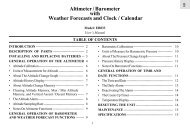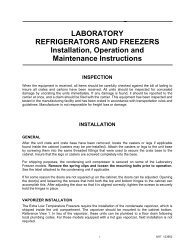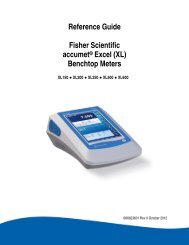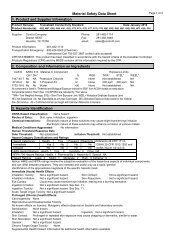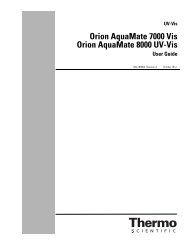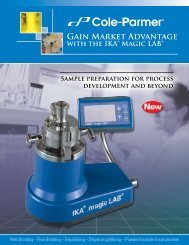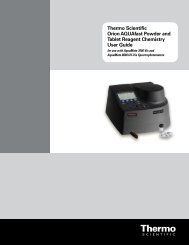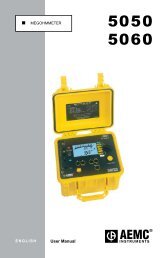Instruction Manuals - Cole-Parmer
Instruction Manuals - Cole-Parmer
Instruction Manuals - Cole-Parmer
Create successful ePaper yourself
Turn your PDF publications into a flip-book with our unique Google optimized e-Paper software.
<strong>Instruction</strong> Manual pH 1100/ 210011 ELECTRODE CARE11.1 Electrode ActivationDO NOT touch or rub the glass bulb. If you follow the storage and maintenance procedure, you can use your electrodeimmediately. If the electrode responds sluggishly or drifts, the bulb may be dehydrated. Immerse the electrode in anideal storage solution such as electrode storage solution or pH 4 buffer solution for 1-2 hours to hydrate it. See StoringpH/ORP electrodes below.If this procedure does not hydrate the electrode, reactivate or replace it.Use 2 or 3 point calibration to test your electrode performance. If you do not get good readings, use a different pHelectrode to confirm the meter is working properly. If the results are still not satisfactory, consult your distributor/dealer.11.2 Electrode MaintenancepH electrodes are susceptible to dirt, dehydration and contamination. Clean them regularly depending on the extent andcondition of use.11.3 Storing pH/ORP electrodesFor best results, always keep the bulb wet, preferably in pH storage solution. Other pH buffers or tap water are alsoacceptable. Do not store in de-ionized water. Eutech Instruments/ Oakton Instruments offers a complete range ofelectrode storage and cleaning solutions.After Use1. After each series of measurements, wash the electrode and reference junction in de-ionized water.2. If using a refillable electrode, close the refilling hole by placing its rubber sleeve or stopper plug into its position.3. Store the electrode as mentioned above.Electrode CleaningElectrodes that are mechanically intact can often be restored to normal performance by one or a combination of thefollowing options.Some suggestions for:a. Salt deposits which are normal on all electrodesDissolve the deposit by immersing the electrode in tap water for 10 to 15 minutes. Thoroughly rinse with de-ionizedwater.b. General dirt and protein coatingsSoak the electrode for several hours in the general-purpose electrode cleaning solutions. Rinse in de-ionized or tapwater.c. Oil/Grease FilmsWash the electrode pH bulb in a little dish washing detergent and water. Rinse the electrode tip with de-ionized water.d. Clogged reference junction.Heat a dilute 1% KCl solution or pH 4.01 buffer solution to 60-80°C. Place the sensing portion of the pH electrode intothe heated KCl solution for approximately 30 minutes. Allow the electrode to cool while immersed in some unheated KClsolution or pH 4.01 buffer solution. Rinse with deionized water.55



